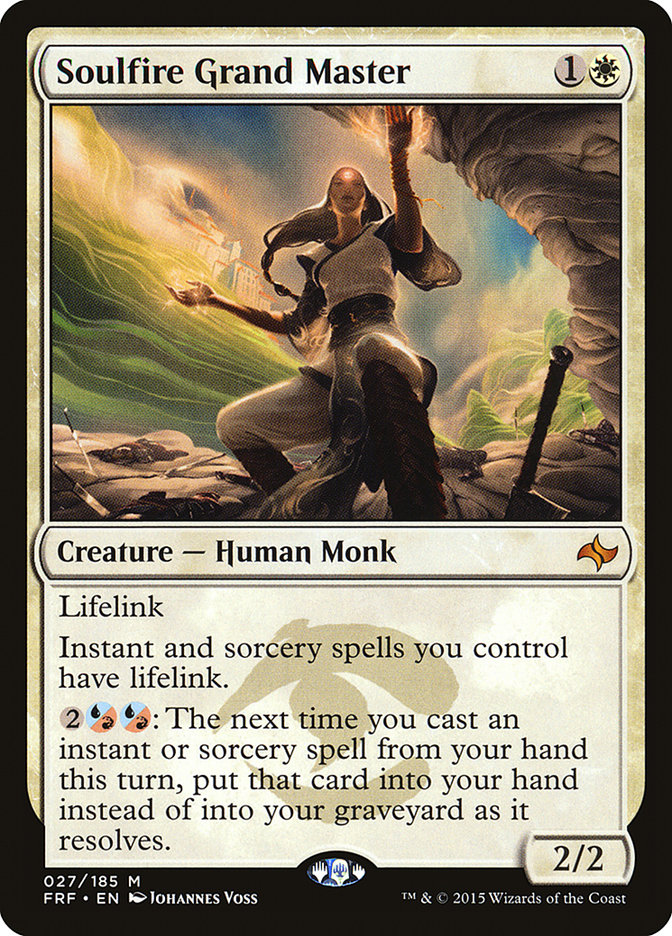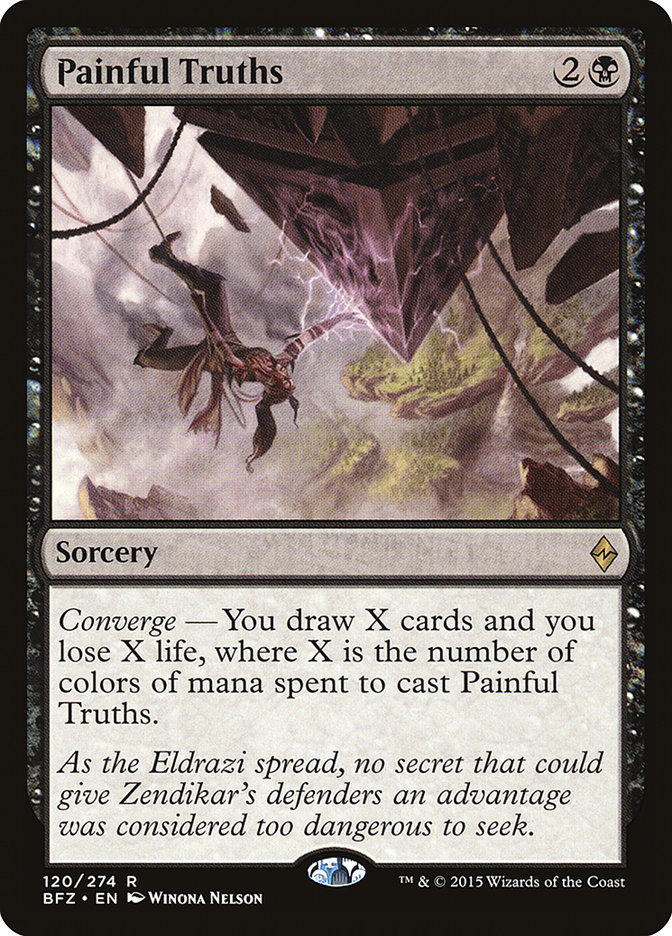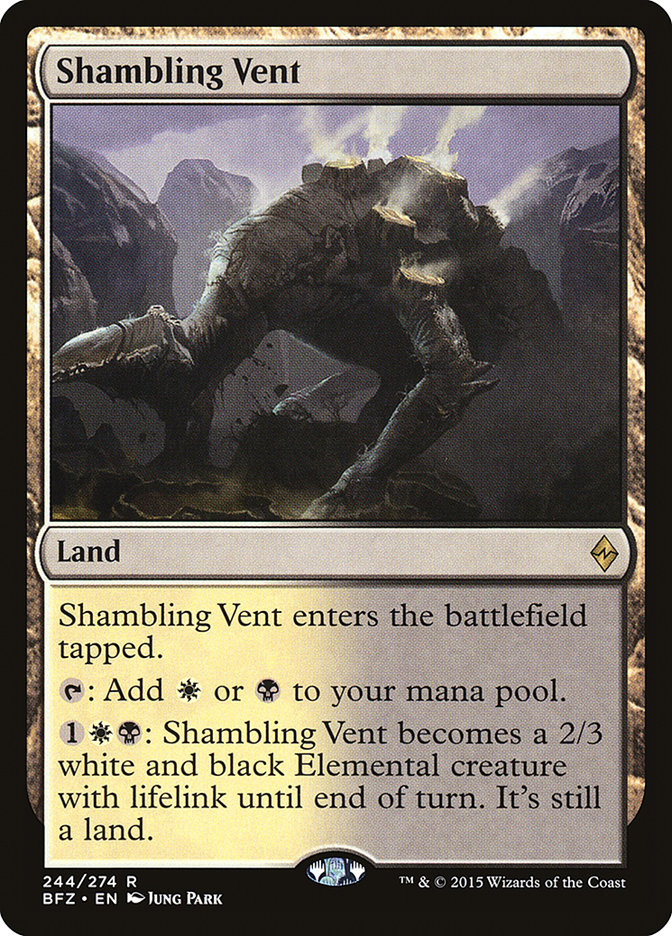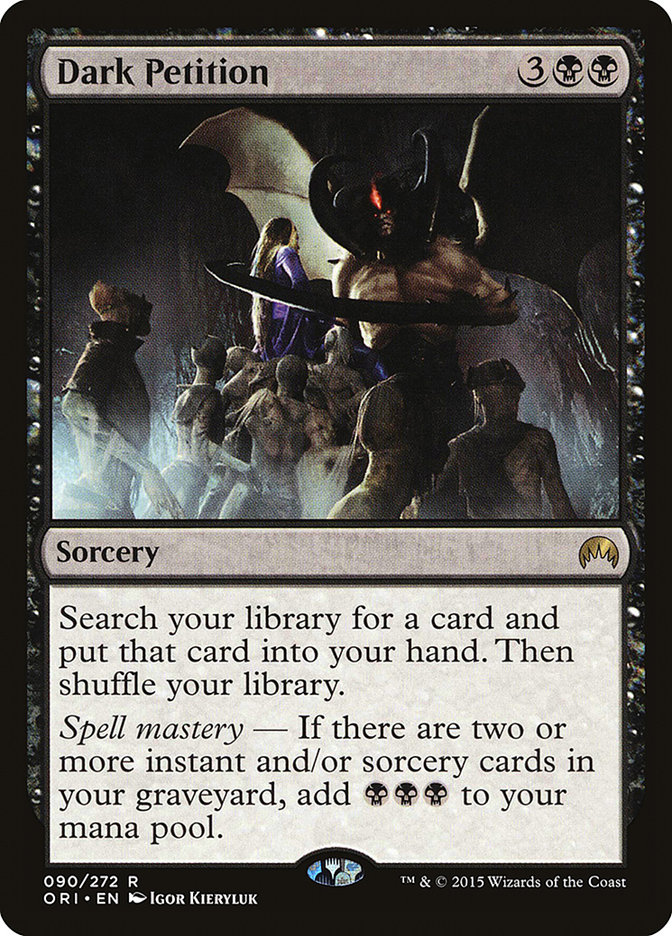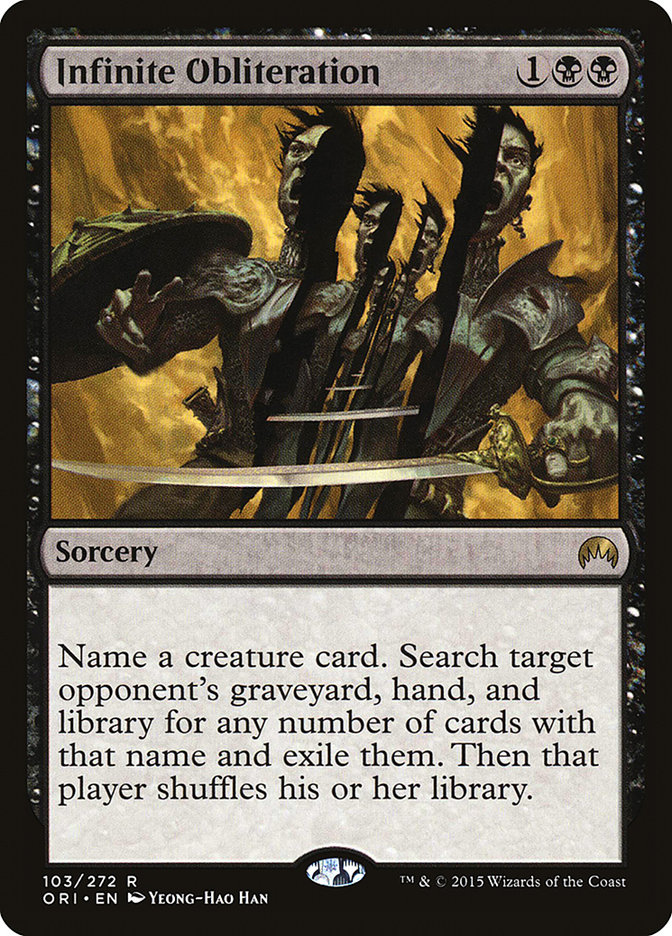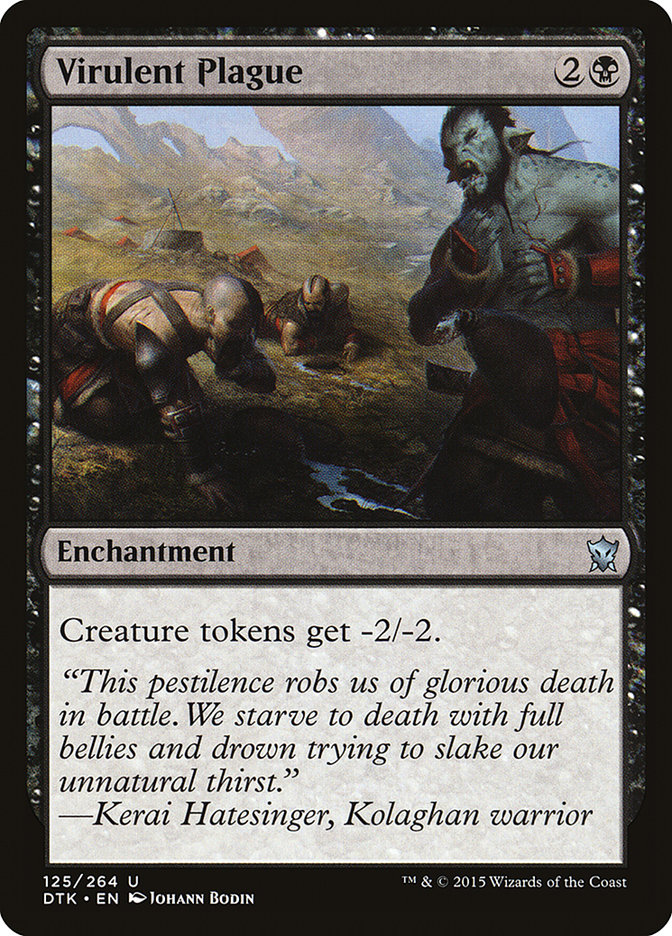I won’t be attending the upcoming #SCGINVI in Las Vegas. If I were, I would play these two archetypes. They certainly aren’t perfect in their current
incarnations, but I think anyone wishing to succeed in the tournament could certainly do so by spending a week testing and improving them.
Standard
Creatures (9)
Lands (26)
Spells (25)

I haven’t let go of the idea of calling this deck Mardu Blue, as it was largely reverse engineered to this point by starting with a heavy Mardu deck
splashing Ojutai’s Command.
Anyways, the obvious question to address is why should you play this deck over Todd Anderson’s Jeskai Black deck? The short answer is that this deck beats
Abzan Aggro.
The long answer is that Mardu Blue utilizes Soulfire Grand Master to its full potential. Magic is a very different game than it was even four or five years
ago. Lifegain is not simply a nice bonus that can be tacked on a card nowadays, but a powerful tool for letting control decks actually play long games. It
doesn’t matter if you are able to stabilize with a fist full of removal spells if you have to fade your opponent drawing a Siege Rhino for seven turns as
you kill them.
Soulfire Grand Master facilitates having ultimate inevitability with both the lifegain and activated ability while being paired with Ojutai’s Command. The
only card that really compares with its ability to dominate a game completely is Ugin, the Spirit Dragon, an eight-drop.
Now I’m not trying to coddle, as clearly the two-drop has seen a wide variety of play through its tenure in Standard, including earning multiple spots in
Jeskai Black, but I’m playing four.
The major difference in the texture of Mardu Blue and Jeskai Black is that I’m also playing four copies of Painful Truths. By now, I think people are
starting to realize just how incredibly powerful Painful Truths is, but I’d be willing to bet that most would still think I’m crazy for starting the full
four with the lack of Dig Through Times in my deck.
Like I said, we can beat Abzan Aggro, and the means in which we do that is burying them in raw cards and in the ability to play Murderous Cut. Jeskai Black
is often inches from stabilizing against Abzan, but they almost always have difficulty seizing back initiative from the aggressive strategy. The issue is
that Jeskai’s removal is required to line up in the correct manner against Abzan’s ruthlessly efficient creatures, but Jeskai is also typically bottle
necked into playing one spell a turn, usually while getting chip-shot’ed by something that fell through the cracks.
Murderous Cut kills creatures without bias and enables Mardu Blue to play two reactive spells a turn to pull ahead. In combination with the Grand Master,
Murderous Cut can essentially softlock Abzan and other aggressively slanted midrange decks by machine gunning all of their creatures. When this can be
achieved with as little as five mana, it is easy to transition into the lategame and even fight off Wingmate Rocs.
The Grand Master is incredibly mana hungry. This is another distinction between Painful Truths and Dig Through Time. While Dig may be a powerful card, it
is more of a card selection tool than a raw source of card advantage. Between Jace activations and Digs, Jeskai Black often ends up discarding or sifting
through a bunch of excess lands, leaving it difficult to reach a high amount of mana in the lategame. The fact that Painful Truths actually draws the full
three cards makes it easy to hit your eighth land drop and beyond, letting you go absolutely wild with Grand Master and supporting Shambling Vents. It
should also be noted that Painful Truths is excellent after mulliganing, and is completely reasonable to jam on turn 3 in many matchups for discarding
blank spells, whereas Dig is often difficult to deploy before turn 5.
Speaking of Shambling Vents, let’s just say I’m not sure I have a correct manabase. Five enter-the-battlefield-tapped lands is a fair amount, but so far it
hasn’t felt like too much of a hindrance. As it often is with a four-color deck, getting the mana right is pretty tricky despite the fact that my colored
sources are all in places that I’m happy with. Another major point of playing a creature-land is that it makes closing the game much easier. It’s probably
easy to notice Mardu Blue plays no hard win conditions. Most of the time you’re going to grind your opponent down to literal zero resources and kill them
four at a time with a Shambling Vent and a Soulfire Grand Master.
The additional source of lifegain is certainly appreciated, and having another threat built in is great.
Two cards that I had in lists and slowly weeded out were Sarkhan, the Dragonspeaker and Pia and Kiran Nalaar. The former was mostly a nod to Gideon, Ally
of Zendikar and how afraid of it I was. While Sarkhan does an okay job of handling the planeswalker, it is generally a rather weak card, and tapping out
for it in the midgame is not exactly what the deck is interested in doing. Gideon is not an especially easy card to deal with, but between Crackling Doom +
Soulfire Grand Master and Utter End, we certainly have the tools to manage. Even Dragonmaster Outcast is something I’ve considered cutting, but it does
grant some free wins, and the fact that it ties up so little mana and plays well with Ojutai’s Command still makes it a premier threat in these types of
strategies. That doesn’t mean I’m afraid to cut it in matchups that are all about surviving, however. There’s also just the actual concern of being able to
kill our opponent twice in 50 minutes. You will frequently be going to under twenty cards in your library, as the games will typically end with you
exhausting all of your opponent’s resources and killing them two at a time. Conceptually, the deck just wants to be as eternal as possible – every card in
your maindeck wants to be hyper efficient.
The sideboard is largely composed of elements that I’ve been very pleased with. The Dark Petition package lets Mardu Blue play several high impact
singletons that are rather narrow while also being a generically powerful card against midrange and control decks. You really haven’t lived until you’ve
looped Dark Petition with Soulfire Grand Master. It’s certainly not elegant, but it basically ensures that the game is over.
While Infinite Obliteration and Virulent Plague are nice bullets against Esper Dragons, Eldrazi Ramp, Atarka Red, and token strategies, the rest of the
sideboard is fairly normal. I originally had less countermagic, but Negate is still just a great tool against other control decks, and beating Rally
without counters is probably impossible.
The Felidar Cub is more of a carry-over from Todd’s deck, and probably isn’t worth the slot. Silkwrap isn’t nearly as popular as it was even just a few
weeks ago, so I consider this the card worth cutting the most at this stage. On the other hand, I keep thinking about adding a second Ob Nixilis. He is by
far my favorite card against Abzan Aggro and other midrange decks after sideboard, with it basically being impossible to lose a game where you get to untap
with him. On the other hand, I’m typically interested in sideboarding in at least one Dark Petition in these matchups, so I can’t exactly jam my deck up
with a bunch of awkward cards as you also have the option of tutoring for him.
My major points of contention are as follows:
The manabase
. Maybe the answer is to cut a Shambling Vent. I’m sure the optimal mana includes only four enter-the-battlefield tapped lands. That being said, I’ve been
color screwed very little.
Two cards in the maindeck
. Dragonmaster Outcast and Kolaghan’s Command. The former is probably just necessary in real life due to time constraints, but I’ll probably be cutting it
from my deck on Magic Online. I would also probably be inclined to sideboard it out against any non-control deck if I were up a game. This isn’t taking
away from how powerful the card is, you just don’t need it most of the time. The Kolaghan’s Command is just a fine value card that isn’t bad against
anyone, but that doesn’t mean it’s necessarily worth the slot.
The sideboard
. As I said previously, Felidar Cub is probably a relic at this point. The third Duress certainly isn’t particularly high impact, and if you felt strongly
about including another bullet-esque card for the Dark Petition package, I would encourage that change. I could also see an argument for simply including
another counterspell. Otherwise, I’m pretty pleased with how the deck is set up for aggressive strategies, as Radiant Flames is so outrageously powerful
with Soulfire Grand Master, and Arashin Cleric is the roadblock you need. You’re already so heavy on spot removal that Surge of Righteousness just isn’t
the effect you want. The Atarka Red class of matchups are very good though, and I could see shaving a Radiant Flames for another card.
Infinite Obliteration is a pretty underrated card against Esper Dragons, and one probably one of the best things you can be doing if you expect a strong
presence of the archetype at the #SCGINVI. Adding another copy is certainly reasonable. There’s also no shame in just another draw effect like a Treasure
Cruise or Dig Through Time.
I feel rather strongly that this deck is excellent and fixes a lot of the issues Jeskai Black has, namely its weakness to Abzan Aggro. If you have
experience with and enjoy playing that archetype, I would try this version.
Modern
I would register some variant of the most boring Grixis Control deck in history:
Creatures (11)
Lands (23)
Spells (26)

I’ve done nothing but waffle between Modern decks over the last few months and tournaments, so unfortunately I don’t have anything too interesting in mind
for the format. That being said, I do think it likely that the metagame is in a place that it is acceptable to sleeve up a Grixis strategy. Zoo and Burn
are probably back to being slightly played fringe decks, while old favorites, which are good matchups, like Affinity and Twin, are back to winning.
The key is to build your deck so that you can target a few specific sweet spots in-between. Like I said, overall my deck is constructed in a rather boring
manner, but the major changes are:
Removal of Remand for Mana Leak
. Mana Leak is a more reliable answer to the unfair decks and their typically more expensive haymakers. As I’ve said a million times, Grixis does not close
quickly and as a result, it is actually rather important that when are you playing counterspells that they are a permanent solution to the problem.
A single Thoughtseize
. This is just another discard spell, but it hits the Primeval Titans of the world, and helps pair up with Surgical Extractions in our sideboards to
cripple unfair strategies.
The removal suite
. This is the most standardized and non-cute package of hard removal spells I’ve ever published. A common theme whenever I shuffle up Grixis is my constant
desire for my deck to keep coughing up Terminates against just about whomever I’m playing against. Slaughter Pact has always impressed and Brad Nelson’s
love of the card has inspired me to include a copy. It is also excellent to be able to tap out for Pia and Kiran Nalaar while still being protected against
decks like Infect, Affinity, and Splinter Twin. Slaughter Pact is rarely considered to be a part of Grixis’s arsenal.
The sideboard
. Surgical Extraction is my heavily theory-influenced solution to G/R Tron, Amulet Bloom, Grishoalbrand, and other various fringe strategies. On the one
hand, it is naturally good against decks that actually use their graveyard, like Grishoalbrand, but in conjunction with other interaction (and Molten Rain)
it can severely cripple or downright annihilate a combo deck’s ability to win. Breathing room is hugely important to Grixis as, again, it has a lot of
difficulty in actually closing out against these decks in a timely manner. Being able to KO combo opponents with a combination of spells is, I hope, a huge
boon to their arsenal.
You’ll notice a much lower number of Dispels than I’ve typically championed in the past. I think it probably more important to prepare for decks like G/R
Tron and Amulet Bloom at the #SCGINVI than blue mirrors. Further, the copies of Surgical Extraction are far more powerful with an additional Thoughtseize
than the counterspell. A Painful Truths is just a nod to mirrors and B/G/X decks, and I have no reason to believe that it isn’t incredibly powerful. Other
folks have started to play it, and if they have the chance to resolve it while you don’t, I suspect you are likely to get buried quickly.
Most of the other aspects of this deck involves material I’ve covered inother articles, so I won’t be beating you over the head. While I
think this Grixis deck is far more focused than iterations from the past, it’s still not something I would recommend anyone to pick up and play unless they
have experience and/or time to play with the deck. While Jace, Vryn’s Prodigy certainly allows Grixis a ton of opportunity to extract value in longer
games, you won’t be receiving very many free wins with Grixis. Although I hope that some of the changes I have made push the deck further into solving some
of its problems, the configuration I have presented today isn’t even entertaining having a shot against decks like Burn, and that’s simply something you
will have to accept should you play against that strategy or others Grixis isn’t prepared for.
While unfortunately I will not be attending the #SCGINVI in a few weeks, I will certainly be following along with the coverage on Twitch. Best of luck, and
don’t get into too much trouble in Vegas!

